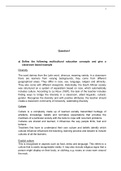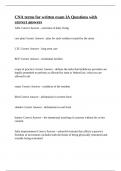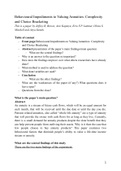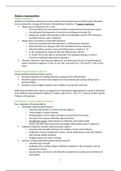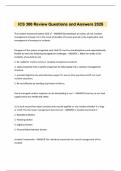1
Question1
a) Define the following multicultural education concepts and give a
classroom based example
Diversity
The word derives from the Latin word, diversus, meaning variety. In a classroom
there are learners from varying backgrounds, they come from different
geographical areas. They differ in race, sex, language, religion and ethnicity.
They also come with different viewpoints. Historically, the South African society
was structured on a system of separatism based on race, which automatically
includes culture. According to Le Roux (1997), the task of the teacher includes
finding ways to bridge the diversity in a classroom, albeit linguistic, cultural,
gender. Recognise the diversity and with positive attributes, the teacher should
create a classroom community of inclusivity, celebrating diversity.
Culture
Culture is a complexity made up of learned socially transmitted heritage of
artefacts, knowledge, beliefs and normative expectations that provides the
members of a particular society with the tools to cope with recurrent problems.
Cultures are shared and learned, it influences the way people think, feel and
behave.
Teachers first have to understand their own culture and beliefs identify which
cultural influence influences the teaching, learning process and beware to include
cultures of all the learners.
Explicit culture
This is recognised in aspects such as food, dress and language. This refers to a
culture that is easily recognisable visibly. It may also include religious signs that a
person might display on their body, or clothing, e.g. rosary or cross worn around
the neck.
, 2
A teacher should look out for these explicit signs, and be careful with the teaching
process, not to offend, but rather include and ask learners to discuss or explain to
fellow learners more about the explicit culture, e.g. why some people are not
allowed to cut their hair, or why their hair should be shaven at a certain age.
b) Define xenophobia. Discuss TWO ways in which teachers can reduce
xenophobia in schools.
Xenophobia is a term to describe hatred or fear of foreigners. It is more
common to use the term to describe a dislike of foreigners. In South Africa,
unfortunately, this concept often leads to intense violence and tension, which
result in injury, destruction and looting.
Teachers can reduce xenophobia, by teaching and educating learners not to
be fearful. By encouraging and creating opportunities to meet and get to know
foreigners, the common dislike, fear and hatred can be eradicated.
c) What does the concept ‘stereotype’ mean? Discuss in your own words
how stereotyping learners can be harmful in a classroom.
Our brains are capable of creating categories for large amounts of
information, or when it is exposed to overwhelming information. This is the
way the brain is able to absorb and quickly process something. The problem
is that these categories are created around people type, situations and
experiences. An example is the colour red. Red is associated with danger, or
love, however not everything red is dangerous or loveable. In a classroom
environment this can be harmful and lead to prejudice, rejection and racism.
Learners need to be made aware what stereotyping is and mean and that it
influence their perception of people or situations that they are not familiar with.
Rather find the person behind the face or race, that just classifying them in a
certain category.
Question 2
a) The teaching situation is essentially a communicative one which is
made more complex by the role of culture. Discuss THREE common
cultural differences in cross-cultural communication. Provide
examples from your own experience as a teacher or learner.
It is impossible to discuss and point out the cultural differences of all the
races in SA. Naturally due to ignorance, cultural differences, when
communicating to a mixed cultural audience can lead to misunderstanding,
incorrect interpretation and incorrect transmission of information.
The first cultural difference I will discuss is the way different cultures,
address each other. There is a different level of formality when using titles
Question1
a) Define the following multicultural education concepts and give a
classroom based example
Diversity
The word derives from the Latin word, diversus, meaning variety. In a classroom
there are learners from varying backgrounds, they come from different
geographical areas. They differ in race, sex, language, religion and ethnicity.
They also come with different viewpoints. Historically, the South African society
was structured on a system of separatism based on race, which automatically
includes culture. According to Le Roux (1997), the task of the teacher includes
finding ways to bridge the diversity in a classroom, albeit linguistic, cultural,
gender. Recognise the diversity and with positive attributes, the teacher should
create a classroom community of inclusivity, celebrating diversity.
Culture
Culture is a complexity made up of learned socially transmitted heritage of
artefacts, knowledge, beliefs and normative expectations that provides the
members of a particular society with the tools to cope with recurrent problems.
Cultures are shared and learned, it influences the way people think, feel and
behave.
Teachers first have to understand their own culture and beliefs identify which
cultural influence influences the teaching, learning process and beware to include
cultures of all the learners.
Explicit culture
This is recognised in aspects such as food, dress and language. This refers to a
culture that is easily recognisable visibly. It may also include religious signs that a
person might display on their body, or clothing, e.g. rosary or cross worn around
the neck.
, 2
A teacher should look out for these explicit signs, and be careful with the teaching
process, not to offend, but rather include and ask learners to discuss or explain to
fellow learners more about the explicit culture, e.g. why some people are not
allowed to cut their hair, or why their hair should be shaven at a certain age.
b) Define xenophobia. Discuss TWO ways in which teachers can reduce
xenophobia in schools.
Xenophobia is a term to describe hatred or fear of foreigners. It is more
common to use the term to describe a dislike of foreigners. In South Africa,
unfortunately, this concept often leads to intense violence and tension, which
result in injury, destruction and looting.
Teachers can reduce xenophobia, by teaching and educating learners not to
be fearful. By encouraging and creating opportunities to meet and get to know
foreigners, the common dislike, fear and hatred can be eradicated.
c) What does the concept ‘stereotype’ mean? Discuss in your own words
how stereotyping learners can be harmful in a classroom.
Our brains are capable of creating categories for large amounts of
information, or when it is exposed to overwhelming information. This is the
way the brain is able to absorb and quickly process something. The problem
is that these categories are created around people type, situations and
experiences. An example is the colour red. Red is associated with danger, or
love, however not everything red is dangerous or loveable. In a classroom
environment this can be harmful and lead to prejudice, rejection and racism.
Learners need to be made aware what stereotyping is and mean and that it
influence their perception of people or situations that they are not familiar with.
Rather find the person behind the face or race, that just classifying them in a
certain category.
Question 2
a) The teaching situation is essentially a communicative one which is
made more complex by the role of culture. Discuss THREE common
cultural differences in cross-cultural communication. Provide
examples from your own experience as a teacher or learner.
It is impossible to discuss and point out the cultural differences of all the
races in SA. Naturally due to ignorance, cultural differences, when
communicating to a mixed cultural audience can lead to misunderstanding,
incorrect interpretation and incorrect transmission of information.
The first cultural difference I will discuss is the way different cultures,
address each other. There is a different level of formality when using titles


